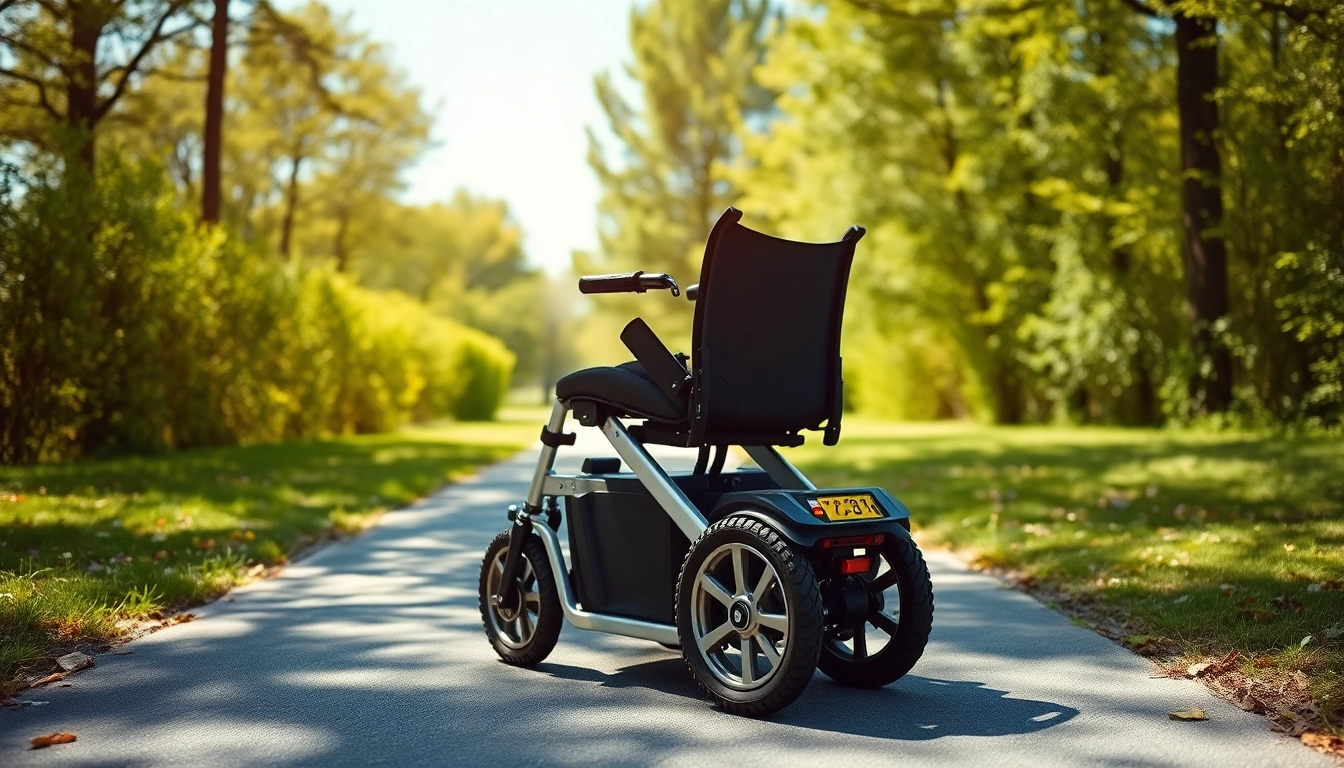
Understanding Electric Wheelchairs
What is an Electric Wheelchair?
An electric wheelchair, often referred to as a power wheelchair, is a mobility device powered by batteries, allowing individuals with physical challenges to navigate their environments with greater ease and independence. Unlike manual wheelchairs, which require physical exertion to propel, electric wheelchairs offer powered movement with a joystick or other control mechanism, making them suitable for users with limited strength or endurance.
These devices come in various designs, catering to different needs—from everyday use to heavy-duty applications. With advanced technology, electric wheelchairs enhance mobility and increase autonomy, significantly improving the quality of life for users.
Key Features of Electric Wheelchairs
Electric wheelchairs are designed with a variety of features to accommodate the diverse needs of users. Key features include:
- Motor Power: Varies from 100W to 1000W, impacting speed and terrain capability.
- Battery Life: Typically between 20 to 40 miles per charge, depending on usage and model.
- Controls: Joystick or alternative controls providing ease of navigation.
- Seating Options: Adjustable seating for comfort, including reclining and elevating features.
- Wheels: Different types, such as pneumatic or solid tires, catering to indoor or outdoor use.
Benefits of Electric Wheelchair Use
The benefits of using an electric wheelchair extend beyond mere mobility. Key advantages include:
- Enhanced Independence: Users can manage transportation without assistance, fostering a sense of autonomy.
- Reduced Physical Strain: Unlike manual wheelchairs, which require significant upper body strength, electric models minimize physical exertion.
- Increased Access: Many models are designed to navigate various terrains, including ramps and uneven surfaces.
- Comfort Features: Custom seating options and ergonomic designs support long periods of use without discomfort.
- Technological Integration: Many electric wheelchairs come with advanced technologies, such as Bluetooth connectivity and user-friendly controls.
Types of Electric Wheelchairs
Standard vs. Heavy-Duty Electric Wheelchairs
Electric wheelchairs can generally be categorized into standard and heavy-duty options, each serving different user needs:
- Standard Electric Wheelchairs: Designed for everyday use with moderate weight capacities. They are ideal for indoor use and light outdoor terrain.
- Heavy-Duty Electric Wheelchairs: Built to support users weighing over 300 pounds, these models are robust, capable of handling rough terrain, and often feature reinforced frames and wider seating.
Portable Electric Wheelchairs: Pros and Cons
Portability is a key consideration for many users. Portable electric wheelchairs present specific advantages and challenges:
Pros:
- Lightweight: Often designed to be compact and light, making them easy to transport and store.
- Folding Capability: Many models can be easily folded, fitting in cars and helping users travel without hassle.
- Convenience: Perfect for those who need a mobility device for travel, enabling freedom and exploration.
Cons:
- Weight Capacity: These models usually support less weight than their heavier counterparts.
- Battery Life: May have shorter battery life compared to standard electric wheelchairs due to size.
- Limited Features: Often fewer technological features and customization options.
Customized Electric Wheelchairs for Individual Needs
Customization plays a significant role in ensuring that an electric wheelchair meets the specific needs of its user. Tailored options may include:
- Seat Width and Depth: Ensuring a perfect fit for comfort and usability.
- Control Mechanism: Different options like joysticks, sip-and-puff systems, or specialized switches.
- Posture Support: Adjustments for better posture and long-term comfort.
Consultation with occupational therapists and wheelchair specialists can help users identify the necessary customizations to enhance functionality and comfort.
Choosing the Right Electric Wheelchair for You
Assessing Your Mobility Needs
Choosing the right electric wheelchair begins with a thorough assessment of your mobility needs. Considerations include:
- Physical Condition: Limitations in strength, endurance, or coordination determine the necessary features.
- Environment: Identify whether the wheelchair will primarily be used indoors, outdoors, or both.
- Personal Preferences: Factors such as the desired seat style, control type, and overall appearance also play a role.
Factors to Consider in Wheelchair Selection
Several critical factors influence the selection of an electric wheelchair, such as:
- Budget: Establishing a budget determines the range of options available.
- Specifications: Power, battery life, and weight capacity should align with your mobility requirements.
- Resale Value: Consider models with good resale potential if upgrading in the future.
Top Brands for Electric Wheelchairs
Investing in a reputable brand ensures quality and reliability. Some leading manufacturers known for their electric wheelchairs include:
- Pride Mobility: Renowned for innovative designs and a diverse range of products.
- Quantum Rehab: Specializes in advanced technology and customized solutions.
- Invacare: Offers reliable options known for their durability and user-friendliness.
Evaluating user reviews and trying different models at local suppliers can provide valuable insights before a purchase.
Cost and Maintenance of Electric Wheelchairs
Understanding the Price Range of Electric Wheelchairs
The cost of electric wheelchairs varies significantly based on features, brand, and type. Generally:
- Standard Models: Can range from $1,500 to $5,000.
- Heavy-Duty Models: Often priced between $3,000 to $10,000.
- Customization and High-End Models: Might exceed $10,000, particularly if equipped with advanced features or specialized adjustments.
Potential users should investigate financial assistance options, including grants or loans, to help mitigate costs.
Maintenance Tips for Longevity
Proper maintenance extends the lifespan of electric wheelchairs. Effective maintenance practices include:
- Regular Battery Checks: Ensure batteries are charged properly and check for any signs of wear.
- Cleaning: Wipe down the chair regularly to prevent dirt buildup and corrosion.
- Inspection: Periodically inspect hardware for loose screws and proper operation of wheels and controls.
Additionally, scheduling periodic professional maintenance can ensure that all systems, including the electronic components, are functioning correctly.
Insurance Coverage and Financial Assistance Options
Many individuals wonder about insurance coverage related to electric wheelchairs. Coverage options include:
- Medicare and Medicaid: May cover a portion of the cost if specific criteria are met.
- Private Insurance: Often varies by plan; consult the provider for specific coverage information.
- Nonprofits and Charities: Organizations may provide financial assistance or special programs for those in need.
Understanding individual coverage options and advocating for your needs when negotiating can greatly benefit the financial aspect of acquiring an electric wheelchair.
Future Trends in Electric Wheelchairs
Innovations in Electric Wheelchair Technology
The future of electric wheelchairs is bright, driven by innovative technology. Emerging trends include:
- Smart Mobility: Integration with health monitoring systems to track mobility patterns and health indicators.
- Improved Battery Technology: Advancements in lithium and solid-state batteries promise longer life and faster charging.
- Enhanced User Interfaces: Simplified control systems for better accessibility and functionality.
What to Expect from Future Electric Wheelchairs
As technology evolves, users can anticipate more versatile and user-friendly electric wheelchairs. Key developments may include:
- Autonomous Navigation: Systems enabling wheelchairs to navigate independently in complex environments.
- Personalization Algorithms: Custom adjustments based on user preferences and usage patterns.
- Virtual Reality Integration: Training and rehabilitation programs may incorporate VR to enhance user experience.
The Impact of Smart Technology on Electric Wheelchairs
The rise of smart technology is set to revolutionize electric wheelchairs by improving connectivity and usability. Benefits include:
- Apps for User Customization: Allow users to tailor their wheelchair settings via smartphone applications.
- Remote Diagnostics: Enable technicians to troubleshoot issues without needing a physical visit.
- Data Collection: User data can inform future product design and enhance personalized wheelchair features.
As electric wheelchairs continue to evolve, staying informed about these advancements ensures you make the best choice for your mobility needs now and in the future.







